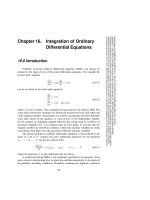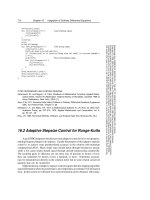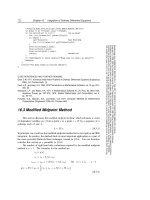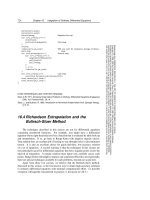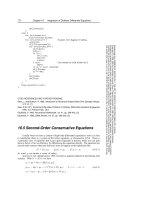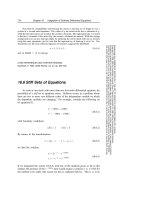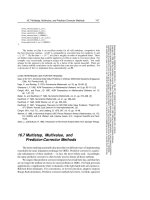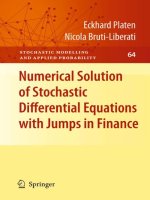NUMERICAL SOLUTIONS OF ORDINARY DIFFERENTIAL EQUATIONS
Bạn đang xem bản rút gọn của tài liệu. Xem và tải ngay bản đầy đủ của tài liệu tại đây (395.32 KB, 35 trang )
1
School of Chemical Engineering and Advanced Materials
Newcastle University
NUMERICAL SOLUTIONS
OF
ORDINARY DIFFERENTIAL EQUATIONS
School of Chemical Engineering and Advanced Materials
Newcastle University
2
ODEs in Chemical Engineering
•
The ODEs that occur in Chemical Engineering tend to be of the following form:
•
Following the previous steps, the solution is provided by:
•
Numerical methods based on “rectangular” and “trapezoidal” rules cannot be used
Problem:
Solution of x depends on x !
( )
( , )
dx t
f x t
dt
=
( ) ( , ).dx t f x t dt=
( ) ( ) ( , ).x t dx t f x t dt= =
∫ ∫
School of Chemical Engineering and Advanced Materials
Newcastle University
3
Integration via Taylor Series Expansion
•
Alternative methods have to be employed and all are based on the Taylor Series
•
Note: any function can be expanded as a Taylor Series
•
The series can be used to solve
Taylor Series expansion of x(t) about t
0
' 2 ''
0 0 0 0 0
3 ''' 4 (4)'
0 0 0 0
1
( ) ( ) ( ) ( ) ( ) ( )
2
1 1
( ) ( ) ( ) ( )
3! 4!
x t x t t t x t t t x t
t t x t t t x t
= + − + −
+ − + − +K
( )
( , )
dx t
f x t
dt
=
School of Chemical Engineering and Advanced Materials
Newcastle University
4
Example: solution via Taylor Series
t 0 1 2 3 …
x(t) x(0) x(1) x(2) x(3)
…
Given initial conditions:
( , ) '( )
dx
f x t x t
dt
= =
x t x t t t x t t t x t( ) ( ) ( ) ( ) ( ) ( )
' ''
= + − + − +
0 0 0 0
2
0
1
2
' 2 ''
0
1
( ) (0) . (0) . (0) , 0
2
x t x t x t x t= + + + =K
' ''
(0), (0), (0)x x x
School of Chemical Engineering and Advanced Materials
Newcastle University
5
Solution using Taylor Series
•
Accuracy of this solution is dependent on the ‘order’ of the Taylor Series expansion
•
Need to have the higher order differentials of x(t) to maintain accuracy
–
may not be available due to the complexity of the original equation
•
Method is not iterative and thus not amenable for efficient implementation on a computer
•
Nevertheless, the Taylor Series approach is the basis for all numerical ODE solution procedures
x t x t t t x t t t x t( ) ( ) ( ) ( ) ( ) ( )
' ''
= + − + − +
0 0 0 0
2
0
1
2
School of Chemical Engineering and Advanced Materials
Newcastle University
6
Euler’s Method: derivation
•
Euler’s Method is based on the first-order Taylor Series
At t = t
1
, the value of x is:
At t = t
2
, the value of x is:
At t = t
3
, the value of x is:
and so on …
'
0 0 0
ˆ
( ) ( ) ( ) ( ) ( )x t x t x t t t x t≈ = + −
x t x t x t t t x t( )
( ) ( ) ( ) ( )
'
1 1 0 1 0 0
≈ = + −
x t x t x t t t x t( )
( ) ( ) ( ) ( )
'
2 2 0 2 0 0
≈ = + −
x t x t x t t t x t( )
( ) ( ) ( ) ( )
'
3 3 0 3 0 0
≈ = + −
School of Chemical Engineering and Advanced Materials
Newcastle University
7
Euler’s Method: derivation
•
Note that all the values of x have
been calculated using a fixed
reference, t
0
.
x(t)
t
t
0
t
1
t
2
x(t
1
)
x(t
2
)
x’(t
0
)
x(t
0
)
x t x t x t t t x t( )
( ) ( ) ( ) ( )
'
1 1 0 1 0 0
≈ = + −
x t x t x t t t x t( )
( ) ( ) ( ) ( )
'
2 2 0 2 0 0
≈ = + −
x t x t x t t t x t( )
( ) ( ) ( ) ( )
'
3 3 0 3 0 0
≈ = + −
School of Chemical Engineering and Advanced Materials
Newcastle University
8
Euler’s Method: derivation
x(t)
t
t
0
t
1
t
2
x(t
1
)
x(t
2
)
x’(t
0
)
x(t
0
)
•
The gradient at the reference point, t
0
, is used
to project to another value of x
•
Assumes that the function is a straight line over
the interval
x t x t x t t t x t( )
( ) ( ) ( ) ( )
'
1 1 0 1 0 0
≈ = + −
x t x t x t t t x t( )
( ) ( ) ( ) ( )
'
2 2 0 2 0 0
≈ = + −
'
1 0
0
1 0
( ) ( )
( )
( )
x t x t
x t
t t
−
=
−
'
2 0
0
2 0
( ) ( )
( )
( )
x t x t
x t
t t
−
=
−
School of Chemical Engineering and Advanced Materials
Newcastle University
9
Euler’s Method: derivation
•
The use of a fixed reference point can lead to large errors
•
Because of the fixed reference point, the interval keeps on changing and this leads to computational
inefficiency
•
Euler’s Method attempts to overcome these deficiencies by:
–
having a moving reference each time a solution value is calculated
–
the solution evolves over constant intervals
School of Chemical Engineering and Advanced Materials
Newcastle University
10
Euler’s Method: derivation
•
Instead of
•
Use:
etc.
etc.
x t x t x t t t x t( )
( ) ( ) ( ) ( )
'
1 1 0 1 0 0
≈ = + −
x t x t x t t t x t( )
( ) ( ) ( ) ( )
'
2 2 0 2 0 0
≈ = + −
x t x t x t t t x t( )
( ) ( ) ( ) ( )
'
3 3 0 3 0 0
≈ = + −
'
1 1 0 0
ˆ
( ) ( ) ( ) . ( )x t x t x t t x t≈ = + ∆
'
2 2 1 1
ˆ
( ) ( ) ( ) . ( )x t x t x t t x t≈ = + ∆
'
3 3 2 2
ˆ
( ) ( ) ( ) . ( )x t x t x t t x t≈ = + ∆
'
ˆ ˆ
( ) ( ) . ( )x t t x t t x t+ ∆ = + ∆
School of Chemical Engineering and Advanced Materials
Newcastle University
11
Euler’s Method: geometric interpretation
x(t)
t
t
0
t
1
t
2
x(t
1
)
x(t
2
)
x’(t
0
)
x(t
0
)
∆t
∆t
x’(t
1
)
x’(t
2
)
∆t
t
3
x(t
3
)
'
ˆ ˆ
( ) ( ) . ( )x t t x t t x t+ ∆ = + ∆
School of Chemical Engineering and Advanced Materials
Newcastle University
12
Euler’s Method: implementation aspects
•
The formula for Euler’s Method:
is often written as:
•
is always given because it is the
equation that has to be solved
•
is the integration interval and has to be specified
•
Initial conditions are required before the solution can proceed
'
ˆ ˆ
( ) ( ) . ( )x t t x t t x t+ ∆ = + ∆
ˆ ˆ ˆ
( ) ( ) . ( ( ), )x t h x t h f x t t+ = +
( )
( ( ), )
dx t
f x t t
dt
=
h t= ∆
School of Chemical Engineering and Advanced Materials
Newcastle University
13
Euler’s Method: accuracy
•
Euler’s Method can be applied to a wide range of ODEs
•
However, except for the simplest of problems, the integration interval has to be small for accuracy
•
Time to solution becomes longer when integration intervals are too small,
•
There have been many attempts to improve the efficiency and accuracy of the basic Euler’s Method,
resulting in a whole family of algorithms for the numerical solution of ODEs
–
Improved Euler’s Method
–
Modified Euler’s Method
–
Runge-Kutta algorithms
School of Chemical Engineering and Advanced Materials
Newcastle University
14
Improved Euler’s Method
•
The basic Euler’s Method formula is changed to:
•
Problem: requires which has yet to be calculated
Average of 2 gradients
one evaluated at t and the other at t+h
( ) ( )
ˆ ˆ
( ), ( ),
ˆ ˆ
( ) ( )
2
f x t t f x t h t h
x t h x t h
+ + +
+ = +
ˆ
( )x t h+
School of Chemical Engineering and Advanced Materials
Newcastle University
15
Improved Euler’s Method
•
Since is unknown, cannot be evaluated
•
To overcome this problem, perform a first estimate using the basic Euler’s Method
•
Then use in:
( )
( )
( )
( ),x t h x t hf x t t
1
+ = +
( )
( )
( )
( )
( ),
( ),
x t h x t h
f x t t f x t h t h
+ = +
+ + +
1
2
( ) ( )
ˆ ˆ
( ), ( ),
ˆ ˆ
( ) ( )
2
f x t t f x t h t h
x t h x t h
+ + +
+ = +
ˆ
( )x t h+
( )
ˆ
( ),f x t h t h+ +
School of Chemical Engineering and Advanced Materials
Newcastle University
16
Improved Euler’s Method: geometric interpretation
x(t)
t
t
0
x(t
0
)
h=∆t
t
1
( ) ( )
1
ˆ ˆ
( ), ( ),
ˆ ˆ
( ) ( )
2
f x t t f x t h t h
x t h x t h
+ + +
+ = +
( )
1
ˆ ˆ ˆ
( ) ( ) ( ),x t h x t hf x t t+ = +
1 1
ˆ
( )x t
( )
1 1 1
ˆ
( ),f x t t
( )
0 0
( ),f x t t
( ) ( )
0 0 1 1 1
ˆ
( ), ( ),
2
f x t t f x t t+
1
ˆ
( )x t
School of Chemical Engineering and Advanced Materials
Newcastle University
17
Modified Euler’s Method
•
Is another variation of the basic Euler’s Method with the aim of improving accuracy
•
It makes use of a gradient evaluated between integration intervals to generate the solutions to the
underlying ODE
•
Problem: again, the formula requires which has yet to be calculated
ˆ ˆ
( ) ( )
ˆ ˆ
( ) ( ) ,
2 2
x t x t h h
x t h x t hf t
+ +
+ = + +
÷
ˆ
( )x t h+
School of Chemical Engineering and Advanced Materials
Newcastle University
18
Modified Euler’s Method
•
The unknown is first estimated using the basic Euler’s formula:
( )
( )
( )
( )
,x t h x t hf
x t x t h
t
h
+ = +
+ +
+
1
2 2
( )
( )
( )
( ),x t h x t hf x t t
1
+ = +
ˆ ˆ
( ) ( )
ˆ ˆ
( ) ( ) ,
2 2
x t x t h h
x t h x t hf t
+ +
+ = + +
÷
ˆ
( )x t h+
School of Chemical Engineering and Advanced Materials
Newcastle University
19
Modified Euler’s Method: geometric interpretation
x(t)
t
t
0
x(t
0
)
h=∆t
t
1
h/2
( )
1
ˆ ˆ ˆ
( ) ( ) ( ),x t h x t hf x t t+ = +
1 1
ˆ
( )x t
( )
0 0
( ),f x t t
1
ˆ ˆ
( ) ( )
ˆ ˆ
( ) ( ) ,
2 2
x t x t h
h
x t h x t hf t
+ +
+ = + +
÷
0 1
ˆ
( ) ( )
,
2 2
x t x t
h
f t
+
+
÷
0 1 1
ˆ
( ) ( )
2
x t x t+
1
ˆ
( )x t
School of Chemical Engineering and Advanced Materials
Newcastle University
20
Euler’s Methods and variations
Euler’s Method
Improved
Euler’s Method
Modified
Euler’s Method
ˆ ˆ ˆ
( ) ( ) . ( ( ), )x t h x t h f x t t+ = +
( )
( )
( )
( ),x t h x t hf x t t
1
+ = +
( )
( )
( )
( )
( ),
( ),
x t h x t h
f x t t f x t h t h
+ = +
+ + +
1
2
( )
( )
( )
( )
,x t h x t hf
x t x t h
t
h
+ = +
+ +
+
1
2 2
( )
( )
( )
( ),x t h x t hf x t t
1
+ = +
School of Chemical Engineering and Advanced Materials
Newcastle University
21
General form of ODE solution methods
•
New value
= old value + integration interval × function of gradient
•
This is the basis for a family of algorithms used to provide numerical solutions of ODEs
•
A particular class is the Runge-Kutta algorithms
[ ]
ˆ ˆ ˆ
( ) ( ) ( ( ), )x t h x t h function f x t t+ = + ×
School of Chemical Engineering and Advanced Materials
Newcastle University
22
Runge-Kutta (RK) Algorithms
•
approximates the terms
•
are coefficients
•
The order of the solution is given by ‘n’
•
Theoretically, the higher the order of the solution, the more accurate is the method
1
ˆ ˆ
( ) ( )
n
i i
i
x t h x t a k
=
+ = +
∑
, 1, 2, ,
i
k i n= K
hf (.)
, 1, 2, ,
i
a i n= K
School of Chemical Engineering and Advanced Materials
Newcastle University
23
Special cases of RK algorithms
General form of RK algorithms
Basic Euler’s Method
Improved
Euler’s Method
Modified
Euler’s Method
1
ˆ ˆ
( ) ( )
n
i i
i
x t h x t a k
=
+ = +
∑
1 1
ˆ
1, ( ( ), )If a k hf x t t= =
1 2
1 1 1
1
;
2
ˆ ˆ
( ( ), ); ( ( ) , )
If a a
k hf x t t k hf x t k t h
= =
= = + +
1 2
1
1 2
0; 1;
ˆˆ
( ( ), ); ( ( ) , )
2 2
If a a
k
h
k h f x t t k h f x t t
= =
= = + +
School of Chemical Engineering and Advanced Materials
Newcastle University
24
RK4 Algorithm (4
th
order method)
( )
( )
( )x t h x t k k k k+ = + + + +
1
6
2 2
1 2 3 4
( )
k hf x t t
1
=
( ),
k hf x t
k
t
h
2
1
2 2
= + +
( ) ,
k hf x t
k
t
h
3
2
2 2
= + +
( ) ,
( )
k hf x t k t h
4 3
= + +
( ) ,
School of Chemical Engineering and Advanced Materials
Newcastle University
25
Solving sets of 1
st
order ODEs
•
Chemical engineering systems are often described by more than 1 ODE, e.g. dynamic material and
energy balances
•
At each integration interval, the equations are solved one at a time, using the same methods as for
single ODEs,
dx
dt
f t x i n
i
1
1
1 2= =( , , , , )
dx
dt
f t x i n
i
2
2
1 2= =( , , , , )
dx
dt
f t x i n
n
n i
= =( , , , , )1 2
